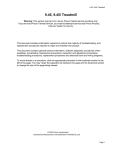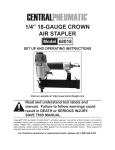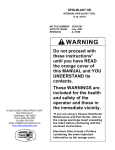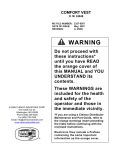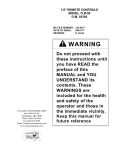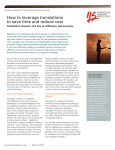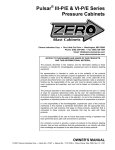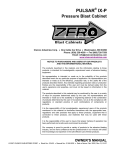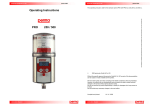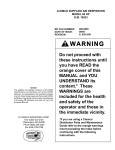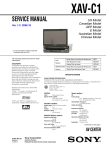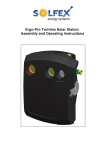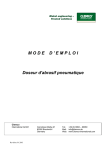Download Sentinel Media Metering Valve (Rev. F)
Transcript
SENTINEL MEDIA METERING VALVE O. M. 20951 MC FILE NUMBER: 1064-0193 DATE OF ISSUE: 04/93 REVISION: F, 10/08 WARNING © 2008 CLEMCO INDUSTRIES CORP. One Cable Car Dr. Washington, MO 63090 Phone (636) 239-4300 Fax (800) 726-7559 Email: [email protected] www.clemcoindustries.com Do not proceed with these instructions until you have READ the orange cover of this MANUAL and YOU UNDERSTAND its contents. * These WARNINGS are included for the health and safety of the operator and those in the immediate vicinity. *If you are using a Clemco Distributor Maintenance and Part Guide, refer to the orange warnings insert preceding the Index before continuing with the enclosed instructions. Electronic files include a Preface containing the same important information as the orange cover. PREFACE GENERAL INSTRUCTIONS WARNING • • • Described herein are some, BUT NOT ALL, of the major requirements for safe and productive use of blast machines, remote control systems, operator respirator assemblies, and related accessories. Completely read ALL instruction manuals prior to using equipment. Read and follow ALL instructions before using this equipment. Failure to comply with ALL instructions can result in serious injury or death. In the event that the user, or any assistants of the user of this equipment cannot read or cannot completely understand the warnings and information contained in these instructions, the employer of the user and his assistants must thoroughly educate and train them on the proper operation and safety procedures of this equipment. The user's work environment may include certain HAZARDS related to the abrasive blasting operation. Proper protection for the blaster, as well as anyone else that may be EXPOSED to the hazards generated by the blasting process, is the responsibility of the user and/or the employer. Operators MUST consult with their employer about what hazards may be present in the work environment including, but not limited to, exposure to dust that may contain TOXIC MATERIALS due to the presence of silica, cyanide, arsenic or other toxins in the abrasive, or materials present in the surface to be blasted such as lead or heavy metals in coatings. The environment may also include fumes that may be present from adjacent coatings application, contaminated water, engine exhaust, chemicals, and asbestos. The work area may include PHYSICAL HAZARDS such as an uneven work surface, poor visibility, excess noise, and electrical hazards. The operator MUST consult with his employer on the identification of potential hazards, and the appropriate measures that MUST be taken to protect the blaster and others that might be exposed to these hazards. NOTICE TO PURCHASERS AND USERS OF OUR PRODUCTS AND THIS INFORMATIONAL MATERIAL The products described in this material, and the information relating to those products, is intended for knowledgeable, experienced users of abrasive blasting equipment. No representation is intended or made as to the suitability of the products described herein for any particular purpose or application. No representations are intended or made as to the efficiency, production rate, or the useful life of the products described herein. Any estimate regarding production rates or production finishes are the responsibility of the user and must be derived solely from the user’s experience and expertise, and must not be based on information in this material. ALL machines, components and accessories MUST be installed, tested, operated and maintained only by trained, knowledgeable, experienced users. DO NOT modify or substitute any Clemco parts with other types or brands of equipment. Unauthorized modification and parts substitution on supplied air respirators is a violation of OSHA regulations and voids the NIOSH approval. The products described in this material may be combined by the user in a variety of ways for purposes determined solely by the user. No representations are intended or made as to the suitability or engineering balance of the combination of products determined by the user in his selection, nor as to the compliance with regulations or standard practice of such combinations of components or products. OPERATIONAL INSTRUCTIONS Abrasive Blast Equipment is only a component of the range of equipment used in an abrasive blasting job. Other products may include an air compressor, abrasive, scaffolding, hydraulic work platforms or booms, paint spray equipment, dehumidification equipment, air filters and receivers, lights, ventilation equipment, parts handling equipment, specialized respirators, or equipment that while offered by Clemco may have been supplied by others. Each manufacturer and supplier of the other products used in the abrasive blasting job must be contacted for information, training, instruction and warnings with regard to the proper and safe use of their equipment in the particular application for which the equipment is being used. The information provided by Clemco is intended to provide instruction only on Clemco products. All operators must be trained in the proper, safe, use of this equipment. It is the responsibility of the users to familiarize themselves with, and comply with, all appropriate laws, regulations, and safe practices that apply to the use of these products. Consult with your employer about training programs and materials that are available. OPERATOR SAFETY EQUIPMENT WARNING • • • Blast operators and others working in the vicinity of abrasive blasting must always wear properlymaintained, NIOSH-approved, respiratory protection appropriate for the job site hazards. DO NOT USE abrasives containing more than one percent crystalline (free) silica. Ref. NIOSH Alert #92-102 Inhalation of toxic dust (crystalline silica, asbestos, lead paint and other toxins) can lead to serious or fatal disease (silicosis, asbestosis, lead or other poisoning). • ALWAYS wear NIOSH-approved supplied-air respirators as required by OSHA, in the presence of any dust including, but not limited to, handling or loading abrasive; blasting or working in the vicinity of blast jobs; and cleanup of expended abrasive. Prior to removing respirator, an air monitoring Our company is proud to provide a variety of products to the abrasive blasting industry, and we have confidence that the professionals in our industry will utilize their knowledge and expertise in the safe efficient use of these products. I PREFACE instrument should be used to determine when surrounding atmosphere is clear of dust and safe to breathe. equipment. If controls are altered, involuntary activation, which may cause serious injury, can occur. • NIOSH-approved, supplied-air respirators are to be worn ONLY in atmospheres: • NOT IMMEDIATELY dangerous to life or health and, • from which a user can escape WITHOUT using the respirator. • Inspect the air control orifice DAILY for cleanliness. NEVER use welding hose in place of twinline control hose. The internal diameter and rubber composition are UNSAFE for remote control use. • UNLESS OTHERWISE SPECIFIED, maximum working pressure of blast machines and related components MUST NOT exceed National Board approved 125 psig (8.5 BAR). • Clemco supplied-air respirators DO NOT REMOVE OR PROTECT AGAINST CARBON MONOXIDE (CO) OR ANY OTHER TOXIC GAS. Carbon monoxide and toxic gas removal and/or monitoring device must be used in conjunction with respirator to insure safe breathing air. • NEVER weld on blast machine. Welding may affect dimensional integrity of steel wall and WILL VOID National Board approval. • Air supplied to respirator MUST BE AT LEAST GRADE D QUALITY as described in Compressed Gas Association Commodity Specification G-7.1, and as specified by OSHA Regulation 1910.139 (d). • Point nozzle ONLY at structure being blasted. High velocity abrasive particles WILL inflict serious injury. Keep unprotected workers OUT of blast area. • ALWAYS locate compressors to prevent contaminated air (such as CO from engine exhaust) from entering the air intake system. A suitable in-line air purifying sorbent bed and filter or CO Monitor should be installed to assure breathing air quality. • NEVER attempt to manually move blast machine when it contains abrasive. EMPTY machines, up to 6 cu. ft.(270kg) capacity, are designed to be moved: • on flat, smooth surfaces by AT LEAST two people; • with the Clemco "Mule"; or • with other specially designed machine moving devices. • ALWAYS use a NIOSH-approved breathing air hose to connect an appropriate air filter to the respirator. Use of a nonapproved air hose can subject the operator to illness caused by the release of chemical agents used in the manufacture of non-approved breathing air hose. • Larger empty blast machines or ANY blast machine containing abrasive MUST be transported by mechanical lifting equipment. • ALWAYS check to make sure air filter and respirator system hoses are NOT CONNECTED to in-plant lines that contain nitrogen, acetylene or any other non-breathable gas. NEVER use oxygen with air line respirators. NEVER modify air line connections to accommodate air filter/respirator breathing hose WITHOUT FIRST testing content of the air line. FAILURE TO TEST THE AIR LINE MAY RESULT IN DEATH TO THE RESPIRATOR USER. AIR HOSE, BLAST HOSE, COUPLINGS, AND NOZZLE HOLDERS • Air hose, air hose fittings and connectors at compressors and blast machines MUST be FOUR times the size of the nozzle orifice. Air hose lengths MUST be kept as short as possible AND in a straight line. Inspect DAILY and repair leakage IMMEDIATELY. • Blast hose inside diameter MUST be THREE to FOUR times the size of the nozzle orifice. AVOID sharp bends that wear out hose rapidly. Use SHORTEST hose lengths possible to reduce pressure loss. Check blast hose DAILY for soft spots. Repair or replace IMMEDIATELY. • Respirator lenses are designed to protect against rebounding abrasive. They do not protect against flying objects, glare, liquids, radiation or high speed heavy materials. Substitute lenses from sources other than the original respirator manufacturer will void NIOSH-approval of this respirator. • ALWAYS cut loose hose ends square when installing hose couplings and nozzle holders to allow uniform fit of hose to coupling shoulder. NEVER install couplings or nozzle holders that DO NOT provide a TIGHT fit on hose. ALWAYS use manufacturers recommended coupling screws. BLAST MACHINES AND REMOTE CONTROLS • Replace coupling gaskets FREQUENTLY to prevent leakage. Abrasive leakage can result in dangerous coupling failure. ALL gaskets MUST be checked SEVERAL times during a working day for wear, distortion and softness. WARNING • • ALWAYS equip abrasive blast machines with remote controls. Abrasive blast machine operators must wear NIOSHapproved supplied-air respirators (ref: OSHA regulations 1910.94, 1910.132, 1910.139 and 1910.244). • Install safety pins at EVERY coupling connection to prevent accidental disengagement during hose movement. • ALWAYS attach safety cables at ALL air hose AND blast hose coupling connections. Cables relieve tension on hose and control whipping action in the event of a coupling blow-out. • NEVER modify OR substitute remote control parts. Parts from different manufacturers are NOT compatible with Clemco II PREFACE MAINTENANCE of the purchase price, as set forth below: 1. Seller makes no warranty with respect to products used other than in accordance hereunder. 2. On products seller manufactures, seller warrants that all products are to be free from defects in workmanship and materials for a period of one year from date of shipment to buyer, but no warranty is made that the products are fit for a particular purpose. 3. On products which seller buys and resells pursuant to this order, seller warrants that the products shall carry the then standard warranties of the manufacturers thereof, a copy of which shall be made available to customer upon request. 4. The use of any sample or model in connection with this order is for illustrative purposes only and is not to be construed as a warranty that the product will conform to the sample or model. 5. Seller makes no warranty that the products are delivered free of the rightful claim of any third party by way of patent infringement or the like. 6. This warranty is conditioned upon seller’s receipt within ten (10) days after a buyer’s discovery of a defect, of a written notice stating in what specific material respects the product failed to meet this warranty. If such notice is timely given, seller will, at its option, either modify the product or part to correct the defect, replace the product or part with complying products or parts, or refund the amount paid for the defective product, any one of which will constitute the sole liability of seller and a full settlement of all claims. No allowance will be made for alterations or repairs made by other than those authorized by seller without the prior written consent of seller. Buyer shall afford seller prompt and reasonable opportunity to inspect the products for which any claim is made as above stated. • ALWAYS shut off compressor and depressurize blast machine BEFORE doing ANY maintenance. • Always check and clean ALL filters, screens and alarm systems when doing any maintenance. • ALWAYS cage springs BEFORE disassembling valves IF spring-loaded abrasive control valves are used. • ALWAYS completely follow owner's manual instructions and maintain equipment at RECOMMENDED intervals. ADDITIONAL ASSISTANCE • Training and Educational Programs. Clemco Industries Corp. offers a booklet, Blast-Off 2, developed to educate personnel on abrasive blast equipment function and surface preparation techniques. Readers will learn safe and productive use of machines, components and various accessories, including selection of abrasive materials for specific surface profiles and degrees of cleanliness. • The Society for Protective Coatings (SSPC) offers a video training series on protective coatings including one entitled "Surface Preparation." For loan or purchase information, contact SSPC at the address shown below. TECHNICAL DATA AND RESEARCH COMMITTEES • The following associations offer information, materials and videos relating to abrasive blasting and safe operating practices. The Society for Protective Coatings (SSPC) 40 24th Street, Pittsburgh PA 15222-4643 Phone: (412) 281-2331 • FAX (412) 281-9992 Email: [email protected] • Website: www.sspc.org National Association of Corrosion Engineers (NACE) 1440 South Creek Drive, Houston TX 77084 Phone: (281) 228-6200 • FAX (281) 228-6300 Email: [email protected] • Website: www.nace.org American Society for Testing and Materials (ASTM) 100 Barr Harbor Dr., West Conshohocken, PA 19428 Phone (610) 832-9500 • FAX (610) 832-9555 Email: [email protected] • Website: www.astm.org Except as expressly set forth above, all warranties, express, implied or statutory, including implied warranty of merchantability, are hereby disclaimed. DAILY SET-UP CHECK LIST WARNING • • • • NOTICE • This equipment is not intended to be used in an area that might be considered a hazardous location as described in the National Electric Code NFPA 70 1996, article 500. • WARRANTY The following is in lieu of all warranties express, implied or statutory and in no event shall seller or its agents, successors, nominees or assignees, or either, be liable for special or consequential damage arising out of a breach of warranty. This warranty does not apply to any damage or defect resulting from negligent or improper assembly or use of any item by the buyer or its agent or from alteration or attempted repair by any person other than an authorized agent of seller. All used, repaired, modified or altered items are purchased “as is” and with all faults. In no event shall seller be liable for consequential or incidental damages. The sole and exclusive remedy of buyer for breach of warranty by seller shall be repair or replacement of defective parts or, at seller’s option, refund ALL piping, fittings and hoses MUST be checked DAILY for tightness and leakage. ALL equipment and components MUST be thoroughly checked for wear. ALL worn or suspicious parts MUST be replaced. ALL blast operators MUST be properly trained to operate equipment. ALL blast operators MUST be properly outfitted with abrasive resistant clothing, safety shoes, leather gloves and ear protection. BEFORE blasting ALWAYS use the following check list. □ 1. PROPERLY MAINTAINED AIR COMPRESSOR sized to provide sufficient volume (cfm) for nozzle and other tools PLUS a 50% reserve to allow for nozzle wear. Use large compressor outlet and large air hose (4 times the nozzle orifice size). FOLLOW MANUFACTURERS MAINTENANCE INSTRUCTIONS. □ 2. BREATHING AIR COMPRESSOR (oil-less air pump) capable of providing Grade D Quality air located in a dust free, contaminant free area. If oil-lubricated air compressor is used to supply respirator, it should have high temperature monitor and CO monitor or both. If CO monitor is not used, air MUST be tested FREQUENTLY to ensure proper air quality. III PREFACE □ □ 3. Clean, properly maintained NIOSH-APPROVED SUPPLIED-AIR RESPIRATOR. ALL components should ALWAYS be present. NEVER operate without inner lens in place. Thoroughly inspect ALL components DAILY for cleanliness and wear. ANY substitution of parts voids NIOSH approval i.e. cape, lenses, breathing hose, breathing air supply hose, air control valve, cool air or climate control devices. 8. BLAST HOSE with ID 3 to 4 times the nozzle orifice. Lines MUST be run AS STRAIGHT AS POSSIBLE from machine to work area with NO sharp bends. Check DAILY for internal wear and external damage. □ 9. HOSE COUPLINGS, NOZZLE HOLDERS fitted SNUGLY to hose end and installed using PROPER coupling screws. Coupling lugs MUST be snapped FIRMLY into locking position. Gasket MUST form positive seal with safety pins inserted through pin holes. Check gaskets and replace if ANY sign of wear, softness or distortion. ALWAYS install safety cables at every connection to prevent disengagement. Check nozzle holder for worn threads. NEVER MIX DIFFERENT BRANDS OF COMPONENTS. Check each of these components DAILY. □ 4. OSHA required BREATHING AIR FILTER for removal of moisture and particulate matter from breathing air supply. THIS DEVICE DOES NOT REMOVE OR DETECT CARBON MONOXIDE (CO). ALWAYS USE CO MONITOR ALARM. □ 5. ASME CODED BLAST MACHINE sized to hold 1/2 hour abrasive supply. ALWAYS ground machine to eliminate static electricity hazard. Examine pop up valve for alignment. Blast machine MUST be fitted with a screen to keep out foreign objects and a cover to prevent entry of moisture overnight. □ 10. Inspect NOZZLE and GASKET DAILY for wear. Replace nozzle when 1/16" larger than original size or if liner appears cracked. Check nozzle threads for wear. □ 6. AIR LINE FILTER installed AS CLOSE AS POSSIBLE to machine inlet. Sized to match inlet piping or larger air supply line. Clean filter DAILY. Drain OFTEN. □ 11. Use abrasive that is properly sized and free of harmful substances; such as, free silica, cyanide, arsenic or lead. Check material data sheet for presence of toxic or harmful substances. □ 7. REMOTE CONTROLS MUST be in PERFECT operating condition. ONLY use APPROVED spare parts, including twin- line hose. DAILY: test system operation and check button bumper and spring action of lever and lever lock. DO NOT USE WELDING HOSE. □ 12. Test surface to be blasted for toxic substances. Take appropriate, and NIOSH required, protective measures for operator and bystanders which pertain to substances found on the surface to be blasted. 1 Air Compressor 11. Silica-free Abrasive 2. Breathing Air Compressor (or) 2. Ambient Air Pump for low pressure respirator 5. ASME Coded Blast Machine 7. Remote Controls 3. NIOSH Approved Supplied-Air Respirator 6. Air Line Filter 10. Appropriately Sized Nozzle 4. CPF Air-Filter 8. Blast Hose 9. Hose Couplings and Safety Cables IV SENTINEL MEDIA METERING VALVE 1.0 INTRODUCTION 1.1 Scope 1.1.1 This manual covers installation, operation, maintenance, and replacement parts for Clemco Sentinel standard-use and fine-mesh media control valves. 1.1.2 The Sentinel valve is a blast machine component. The operator must be qualified to safely operate the blast machine and remote controls, and all other equipment used with the valve. To ensure safe blasting, all operators and personnel involved with the abrasive blasting process must read and understand the manuals, including the information included in the orange cover, for all devices used with the Sentinel valve. 1.1.3 The Clemco booklet "Abrasive Blasting Safety Practices" contains important safety information about abrasive blasting that may not be included in equipment operation manuals. Copies are available from Clemco Industries and may be requested through our website www.clemcoindustries.com or requested via email to [email protected]. 1.2 Safety Alerts 1.2.1 Clemco uses safety alert signal words, based on ANSI Z535.4-1998, to alert the user of a potentially hazardous situation that may be encountered while operating this equipment. ANSI's definitions of the signal words are as follows: This is the safety alert symbol. It is used to alert the user of this equipment of potential personal injury hazards. Obey all safety messages that follow this symbol to avoid possible injury or death. CAUTION Caution used without the safety alert symbol indicates a potentially hazardous situation which, if not avoided, may result in property damage. CAUTION Caution indicates a potentially hazardous situation which, if not avoided, may result in minor or moderate injury. Page 1 WARNING Warning indicates a potentially hazardous situation which, if not avoided, could result in death or serious injury. DANGER Danger indicates an imminently hazardous situation which, if not avoided, will result in death or serious injury. 1.3 General Description 1.3.1 The Sentinel is a normally-closed, pneumatically-operated media control valve. The valve can be used with a pressure-release system, as shown in Figures 1 and 2, to stop the abrasive flow each time the blast machine is depressurized. It can also be used with a pressure-hold system, to stop the abrasive flow while the machine remains under pressure. If the valve is supplied as part of a Clemco remote system, it will be controlled by a Clemco Abrasive Cutoff Switch (ACS) mounted on the remote control handle. This setup enables the operator to shut off the abrasive flow, allowing air alone to exit the nozzle. This air flow is used to clear abrasive from the blast hose, or for surface blow-down. If the Sentinel valve is not used with a Clemco ACS system, an ACS switch must be installed on the Sentinel as shown in Figure 2. Use the ACS instead of the metering handle to shut off abrasive flow. The ACS is shown under accessories in Section 6.2. 1.3.2 The Sentinel comes in two models, standarduse and fine-mesh. • Standard-use valves are for use with abrasives coarser than 50-mesh. • Fine-mesh valves are for use with abrasives 50mesh and finer. The valves are identical except for the metering plate and a few related parts. To identify the valve, look at the end of the metering plate shaft. Fine-mesh valves have a U stamped on the end; the shaft on standard valves are unmarked. Conversion kits are available to convert from one to the other. See Section 6.1. 1.3.3 Valves are available with or without an inspection opening. Valves without inspection openings are usually used only where height clearance (distance from the bottom of the machine to the ground) is limited. See Figure 3 for nominal dimensions. © 2008 CLEMCO INDUSTRIES CORP. • www.clemcoindustries.com • Manual No. 20951 SENTINEL MEDIA METERING VALVE Page 2 Sentinel valve installed on a blast machine using pressure-release remote controls with ACS switch mounted on the control handle Sentinel Valve Twinline Hose Twinline Hose Single-line Hose 2.0 INSTALLATION WARNING Failure to observe the following procedures before performing service on a blast machine (pressure vessel) could cause serious injury or death from the sudden release of trapped compressed air. • Depressurize the blast machine. • Lockout and tagout the compressed air supply. • Bleed the air supply line to the blast machine. 2.1 Remove abrasive from the blast machine, depressurize the machine, and disconnect the compressed air supply line. 2.2 Remove the existing abrasive metering valve and necessary pipe fittings. NOTE: The following installation describes how to install the valve on a machine with minimal rotation clearance. It is not RLX Control Handle w/ ACS Switch ACS Switch Figure 1 necessary to disassemble the valve if it rotates freely on the bottom of the machine. 2.3 Remove the four cap screws holding the flanged adaptor to the valve assembly. 2.4 Use a 1-1/2" close nipple to connect the flanged adaptor to the outlet at the bottom of the blast machine. If the adaptor has an inspection plate, position the plate toward the blast hose connection. If the adaptor does not have an inspection opening, align the bolt holes fore and aft, with the wide gap toward the blast hose connection. 2.5 Position the adaptor gasket between the flanged adaptor and valve assembly, and bolt the parts together. 2.6 Connect pipe fittings between the wye and existing pusher line. It may be necessary to "fit" with new nipples to align the height of the pusher line with the wye. 2.7 Attach the quick coupling and nipple to the wye. © 2008 CLEMCO INDUSTRIES CORP. • www.clemcoindustries.com • Manual No. 20951 SENTINEL MEDIA METERING VALVE 2.8 Control Hose Connections 2.8.1 If a Clemco remote control with ACS control handle is used, connect the “single” control line to the fitting on the upper body as shown in Figure 1. Refer to the blast machine and remote control manuals for set-up and operation of the particular equipment. 2.8.2 If other machines or control systems are used, the valve should be ordered with the ACS. Note: the ACS switch and fittings are shown under accessories in Section 6.2. Refer to Figures 2 and 5 while making the following changes: Install a tee for the ACS switch before the inlet valve. Air flow Air supply hose to the cut-off switch, is supplied by the user. Page 3 2.8.2.2 Screw the 1/8" hex nipple provided, into the "CYL" port of the ACS switch, and attach it to the upper body. 2.8.2.3 Install the fitting removed in the previous step, (or one that is compatible with the system used), into the "IN" port of the ACS switch. 2.8.2.4 If the Sentinel is installed on a manuallyoperated blast machine, such as in an automated system, connect an air line between the "IN" port fitting and a tee installed before the machine’s air-inlet valve. Refer to the top illustration in Figure 2. 2.8.2.5 If the Sentinel is connected to a remote system, connect the air line from the "IN" port fitting to a controlled air line (one that is on the controlled side of the remote control air line, which will pressurize when the control handle is pressed). One method is to tee off the inlet or outlet valves of the remote system. Doing so closes the valve when the remote controls depressurize the blast machine, resulting in a smoother start when the machine is re-pressurized. Refer to the bottom illustration in Figure 2. ACS cut-off switch Flange Adaptor without Inspection opening Connection with manually-operated machine Air supply hose to the cut-off switch is supplied by the user. Flange Adaptor with Inspection opening This line must be tied into the remote controls, controlled-air circuit. Connection with remote-controlled machine Figure 2 Figure 3 2.8.2.1 Remove the fitting on the upper body cylinder port. 2.8.2.6 If a pressure regulator is used, control air for the Sentinel should be sourced up-stream of the regulator. Doing so allows full line pressure to control the valve © 2008 CLEMCO INDUSTRIES CORP. • www.clemcoindustries.com • Manual No. 20951 SENTINEL MEDIA METERING VALVE while blasting pressure can be adjusted down to approximately 30 psi. The Sentinel valve requires control line pressure to be between 65 psi and 150 psi. WARNING Excessive compressed air pressure could cause a blast machine to rupture. To prevent serious injury or death, do not exceed the rated pressure of the blast machine vessel. Page 4 NOTE: The ACS performs dual functions: Use it to clear abrasive from the blast hose and to blow off abrasive from the blasted surface at the blasting area. Small amounts of abrasive may exit the nozzle with the air. Residual abrasive may remain on the surface, and have to be removed outside the blast area prior to painting. 4.0 MAINTENANCE WARNING 3.0 OPERATION 3.1 When the valve is correctly installed, it opens and closes pneumatically as control-air is applied or removed from the valves actuating piston. If the valve is used in conjunction with the remote control system, it opens when the remote controls begin the blasting process, and closes when the controls stop the blasting process. If the valve is used independently of remote controls, it opens and closes with the use of the ACS switch. 3.2 Abrasive Metering: Abrasive will not flow through the valve unless it is open (see Paragraph 3.1) Abrasive flow is adjusted at the metering handle. The valve is closed when the handle is fully right. To adjust, close the valve and slowly move the handle to the left to increase flow. Use as little abrasive as possible while maintaining the best cleaning rate. Generally, with the correct mixture, abrasive can be seen as light discoloration as it exits the nozzle. The valve is fully open when the handle is fully left. 3.3 Operation of the Abrasive Cut-Off Switch. 3.3.1 The ACS switch is “OFF” (no abrasive) when the toggle is pointing forward toward the nozzle ("EXH" port) or down if installed on the Sentinel valve as shown in Figure 2. Abrasive flow is “ON” when the toggle is pointing backward away from the nozzle ("CYL" port) (up if it is as shown in Figure 2). 3.3.2 By moving the switch to the “OFF” position, the air supply to the Sentinel valve is shut-off and vented through the exhaust port. The Sentinel then closes and abrasive flow stops. This allows the operator to have air alone coming from the nozzle, which can be used to clear the blast hose before shut-down, and to blow abrasive off the blasted surface. The switch can be opened or closed any time, but will not activate the metering valve unless the control handle is pressed. Failure to observe the following procedures before performing any maintenance on a blast machine could cause serious injury from the sudden release of trapped compressed air. • Depressurize the blast machine. • Lockout and tagout the compressed air supply. • Bleed the air supply line to the blast machine. NOTE: The easiest way to service the valve is to remove it from the blast machine. The easiest way to remove the valve is to remove the four bolts holding the flanged adaptor to the valve assembly and disconnecting the pusher line. The valve and lower piping can then be removed as an assembly. The flanged adaptor remains on the machine, but it should be inspected and replaced it worn. 4.1 Removing Upper Body Assembly (shut-off section). 4.1.1 Remove nuts and cap screws holding the upper body onto the flanged adaptor. 4.1.2 Attach an air line to the fitting on the cylinder port on the upper body assembly, and pressurize the line to retract the shut-off piston. NOTE: If air is not available, use care when removing the bolts per Section 4.1.3. 4.1.3 Remove the control handle, gauge unit studs, and the four bolts holding the upper body assembly to the lower assembly. (Note: If the piston was not retracted per Section 4.1.2., loosen the nuts in sequence. Once the nuts are loose, the lower body will be forced away from the upper body by approximately 1/2".) 4.1.4 Remove the upper body assembly. NOTE: The seat, seat plate, and seat plate gaskets will be loose; do not misplace them. © 2008 CLEMCO INDUSTRIES CORP. • www.clemcoindustries.com • Manual No. 20951 SENTINEL MEDIA METERING VALVE 4.1.5 Depressurize the air line to the upper body cylinder port. 4.2 4.3.7 Inspect all parts. Replace any that are worn or damaged. Inspection of Upper Body Assembly 4.4 4.2.1 Remove the six cylinder cap screws and then remove the cap and cap gasket. 4.2.2 Using a 9/16" socket (with impact wrench if available), remove the cap screw from inside the cylinder. The cap screw holds the piston cup to the shutoff piston, and compresses the piston against the spring. As the screw is removed, the spring will decompress, forcing the shut-off piston out of the body assembly. 4.2.3 Remove the shut-off piston and spring. 4.2.4 Remove the wear sleeve. 4.2.5 Remove both u-seals from inside the wear sleeve. 4.2.6 Remove the piston cup by inserting a long 3/8" socket extension, screw driver or similar object through the cup hole and pry upward. 4.2.7 Remove the o-rings from the upper body, one is in the piston stem guide hole, the other is in the wear sleeve cavity. 4.2.8 Inspect all items, including the seat, seat plate and seat plate gaskets. Replace any worn or damaged parts. 4.3 Page 5 Reassembly of Upper Body 4.4.1 Place new o-rings into the groove in the piston stem guide hole and wear sleeve cavity. The o-rings must be completely seated into the grooves. 4.4.2 Lubricate the edge of the piston cup, inside of the cylinder cavity, and o-rings with lightweight oil or light silicone grease. 4.4.3 Insert the piston cup into the cylinder. Do not allow the rubber lip of the cup to curl. Use a dull edge to work the lip into the opening. Once the cup is inserted, push it to the bottom of the cylinder. 4.4.4 Place the spring into the upper valve body. 4.4.5 Insert the shut-off piston, stem first through the guide hole until it bottoms against the spring. 4.4.6 Put new u-seals in the wear sleeve as shown in Figure 4. The seal closest to the flange goes in first, with the seal expansion ring facing the flange. The second useal is placed next to the first with the ring also facing the flange. Wear Sleeve U-Seal Inspection of Lower Body Assembly. 4.3.1 Inspect the lower body assembly for wear or damage. If service is required, use the following instructions to disassemble. Expansion Ring 4.3.2 Lay the valve assembly on a flat service, and push down on the handle to remove the handle pin, handle, and spring. 4.3.3 Push the metering plate and stem assembly through the body. 4.3.4 Remove the shaft gasket from the metering plate stem. 4.3.5 Remove the packing gland from the body, by prying up on the flange or pushing from the bottom. 4.3.6 Remove the o-rings from the lower body and packing gland. Flange Alignment Hole Figure 4 4.4.7 Place the wear sleeve in the body. Align the hole in the sleeves flange with the pin in the body. Make sure the opening in the wear sleeve lines up with the opening in the body. 4.4.8 Working from the piston side, place the flat washer and rubber-backed washer on the piston cup cap screw (rubber on rubber washer against the piston cup). Push the screw through the hole in the cup and screw it into the shut-off piston shaft. As the cap screw is © 2008 CLEMCO INDUSTRIES CORP. • www.clemcoindustries.com • Manual No. 20951 SENTINEL MEDIA METERING VALVE Page 6 tightened, it will compress the spring and draw the shutoff piston and shaft into place. An impact wrench works best for tightening the piston screw. If a hand wrench is used, it may be necessary to grip the shut-off piston with pliers as the screw is tightened. 4.6.6 Put the lower body assembly in place and bolt the upper and lower body assemblies together using the four bolts (do not put the studs in at this time). Handtighten all nuts before tightening them in sequence to uniformly compress the bodies together. 4.4.9 Recheck the alignment of the wear sleeve pin hole. When the hole is aligned, lay a large socket or similar object on the wear sleeve, and tap it until the sleeve is fully seated into the body. 4.6.7 4.5 4.6.9 Reassembly of Lower Body 4.5.1 Place new o-rings in the lower body and packing gland. Lubricate both o-rings. Depressurize and remove the cylinder air line. 4.6.8 Remove the handle, and install the studs and gauge unit assembly. When the gauge unit is in place and studs are tightened, re-install the handle. Bolt the cylinder cap and gasket in place. 4.6.10 Bolt the flanged adaptor and flange gasket onto the body assembly. 4.5.2 Push the packing gland into the lower body until it bottoms-out on the flange. 4.5.3 Place a new shaft gasket over the metering plate stem, and push the stem through the packing gland. Hold the gland in place as the shaft is pushed through. 4.5.4 Put the spring and handle on the stem, position the handle so it points away from the metering plate. 4.5.5 Push on the handle and tap around the top to compress the spring until the handle clears the hole on the stem. 4.5.6 Push the handle pin through the stem to lock the handle in place. 4.5.7 Make sure the handle and metering plate are at 180 degrees. 4.6 Reassembly of Upper and Lower Valve Assemblies. 4.6.1 Apply air to the upper body cylinder to retract the shut-off piston. Set the cylinder end of the upper body on a flat surface. The seat plate flange should be facing up. 4.6.2 Place the rubber seat (the beveled side must face the shut-off piston) into the wear sleeve recess. 4.6.3 Set a seat plate gasket on the upper body seat plate flange. 4.6.4 Place the seat plate on top of the gasket. The two sealing ridges must face toward the rubber seat. 4.6.5 5.0 TROUBLESHOOTING 5.1 No abrasive flow 5.1.1 Metering valve closed. Closed is when the metering handle is fully right. 5.1.2 ACS switch is closed. Switch is closed when the toggle is pointed toward the "EXH" port. 5.1.3 Leak or blockage in the air hose or fittings between the control unit and the Sentinel valve. 5.1.4 Machine empty. 5.1.5 Abrasive or foreign material jamming the valve’s shut-off piston, wear sleeve, spring, or piston cup. Check seals and o-rings. 5.1.6 Cap screw securing piston cup is loose or broken. 5.1.7 Relief hole in cylinder cap is plugged. 5.1.8 Leaks around seat plate gaskets, or flanged adaptor gasket. 5.1.9 Obstruction in media valve. Clear as follows: 5.1.9.1 Fully open the media control valve, (Fully open is when the metering handle is fully left). While blasting, close the choke valve to force out small obstructions or wet abrasive. Set another plate gasket on the seat plate. © 2008 CLEMCO INDUSTRIES CORP. • www.clemcoindustries.com • Manual No. 20951 SENTINEL MEDIA METERING VALVE WARNING To avoid serious injury or death, depressurize the blast machine, lockout and tagout the compressed air supply before continuing. 5.1.9.2 For larger obstructions, shut the machine down to examine the abrasive valve. Remove the inspection plate from the flanged adaptor and clear obstruction. 5.6.2 Abrasive bridging in the blast machine. This is usually caused by using very fine abrasive, or by moist air. See Section 4.1. 6.0 ACCESSORIES and REPLACEMENT PARTS 6.1 Conversion Kits Converts fine-mesh valve to standard-use ............ 22848 Converts standard-use valve to fine-mesh ............ 22849 WARNING Do not stick fingers into the piston area of the inspection opening. The piston is under spring pressure, and could suddenly close when the obstruction is cleared. 6.2 Accessories for Use with Remote Control Applications, Figure 5 Item 5.2 Abrasive flow does not stop when ACS switch is turned off. 1. 5.2.1 Control air is not exhausting from the switch. Check the exhaust muffler for blockage and check the control handle per the control handle manual. 2. 3. 4. 5. 6. 5.2.2 Worn valve seat. 5.2.3 Worn shut-off piston. 5.2.4 5.1.9. Obstruction on the valve seat. See Section 5.3 Metering handle will not move. 5.4 Air leaks through relief hole in cylinder cap. 5.4.1 Worn piston cup. 5.5 Air leaks through relief hole in valve body (spring chamber). 5.5.1 Worn u-seals in wear sleeve, or worn o-ring between the valve body and wear sleeve. flow decreases shortly after Non-Clemco Description .............................................Stock No. Adaptor, straight 1/8" NPT ............................................. 01940 1/4” NPT ............................................. 02494 Adaptor, elbow 1/8" NPT ............................................. 02827 1/4” NPT ............................................. 02513 Connector, 1/8" brass ............................. 01962 Breather muffler, 1/8" .............................. 07657 Valve, 3-way, ACS switch ........................ 07658 Hose, 3/16” coupled 3-foot length ....................................... 02498 5-foot length ....................................... 03083 2 1 5.3.1 Damp or hardened abrasive packed around metering plate. Disassemble valve to clean. 5.6 Abrasive blasting starts. Page 7 6 Item 5 may be remotely mounted using a hose between it and the Sentinel valve 3 5 1 4 5.6.1 Insufficient air supply causing control pressure to drop, in turn closing the valve. Check for undersized air supply hose, and the CFM of compressor against the cfm consumption of the nozzle. © 2008 CLEMCO INDUSTRIES CORP. • www.clemcoindustries.com • Manual No. 20951 Figure 5 SENTINEL MEDIA METERING VALVE (-) 6.3 Replacement Valves (-) Sentinel valve with attached ACS, standard-use for abrasives coarser than 50-mesh, with inspection plate ...........................20508 without inspection opening .................20509 Page 8 Service kit, lower segment, Figure 7..........22389 22389 LOWER-SEGMENT SERVICE KIT Item Qty. Description (-) Sentinel valve, w/o attached ACS, standard-use for abrasives coarser than 50-mesh, with inspection plate ............................20608 without inspection opening ..................20609 (-) Sentinel valve w/o attached ACS, fine-mesh for abrasives 50-mesh and finer with inspection plate ............................21439 6.4 Service Kits (-) Service kit, upper segment, Figure 6 ........22388 1. 2. 3. 4. 1 2 1 2 5. 6. 1 1 22388 UPPER-SEGMENT SERVICE KIT Seat, rubber Gasket, seat plate O-ring, gland, 5/8” ID nom. Gasket, shaft (One is for standard-use [coarse media] has a 1-3/8” nominal OD) (One is for a urethane plate [fine-mesh] has a 1” nominal OD) O-ring, lower body 1” ID O-ring, Inspection plate, 1-3/4” OD nom. 6 Item Qty. Description 1. 2. 3. 4. 5. 6. 7. 8. 9. 10. 11. 1 1 1 2 1 1 1 1 2 1 1 Washer, rubber backed O-ring, piston shaft bore, 3/4” ID nom. Gasket, cylinder cap U-seal O-ring, inspection plate 1-3/4” OD nom. Gasket, flanged adaptor Roll pin, 1/16” x 1/2” O-ring, Main body, 2-1/4” nom. Gasket, seat plate Cap screw, 3/8-NC x 2" Washer, 5/16" flat 2 2 4 5 1 Figure 7 5 3 10, 11, 1 6 2 3 9 9 4 8 7 Figure 6 © 2008 CLEMCO INDUSTRIES CORP. • www.clemcoindustries.com • Manual No. 20951 SENTINEL MEDIA METERING VALVE 6.5 Sentinel Replacement Parts, Figure 8 Item Description............................................Stock No. 1. 2. 3. 4. 5. 6. 7. 8. 9. 10. 11. Cylinder cap .............................................. 20512 Cap screw, 3/8-NC x 1-1/2" ...................... 03267 Adaptor, 1/8" NPT ..................................... 01940 Piston cup ................................................. 20515 Piston, shut-off .......................................... 20494 Spring, 2" OD x 4-1/2" .............................. 20600 Upper body ............................................... 20514 Cap screw, 5/16-NC x 3/4" ....................... 03151 Wear sleeve .............................................. 20495 Seat plate .................................................. 20497 Metering plate and stem Standard-use, coarser than 50-mesh .... 20499 Fine-mesh, Urethane, 50-mesh & finer . 21438 Packing gland ........................................... 21021 Spring, 5/8" ID x 1-11/16" ......................... 01982 Close nipple, 1-1/2" schedule 80............... 01791 Inspection plate ........................................ 02440 Cap screw, 5/16-NC x 1-1/4" .................... 19509 Cap screw, 1/2-NC x 2-1/2" ...................... 03457 12. 13. 14. 15. 16. 17. 18. 19. 20. 21. 22. 23. 24. 25. 26. 27. 28. 29. 30. 31. 32. 33. 34. 35. 36. 37. 38. 39. Page 9 Nut, 1/2-NC hex head ............................... 03511 Metering handle, heavy duty .................... 20498 Pin, valve handle ...................................... 20246 Close nipple, 1-1/4" .................................. 01717 Wye, 1-1/4" standard ................................ 01818 Set screw, 1/4-NC SQ. HD. ...................... 03080 Lower body ............................................... 20511 Flanged adaptor w/ inspection opening ... 20513 Nut, 3/8-NC hex head ............................... 03311 Nut, 5/16-NC wing .................................... 03213 Flanged adaptor w/o inspection opening . 20522 Hitch pin..................................................... 20245 Petcock ...................................................... 01993 Gauge unit ................................................ 02433 Stud, gauge unit ....................................... 02436 Spacer, handle bolt ................................... 02431 Cap screw, 1/4-NC x 1" ............................ 03053 Nut, 1/4-NC wing ...................................... 03113 Washer, 1/4 flat ........................................ 03116 Connector, 1/8” brass ............................... 01962 Valve, 3-way ACS switch........................... 07658 Breather, muffler 1/8” ................................ 07657 14 25 16 15 8 27 7 1 28 2 26 37 4 17 38 3 30 6 3 39 5 13 18 9 19 11 12 10 24 Items not called out are available in service kits only. Refer to Page 8 for service kits. 20 35 21 36 22 29 33 32 34 31 23 Figure 8 © 2008 CLEMCO INDUSTRIES CORP. • www.clemcoindustries.com • Manual No. 20951














